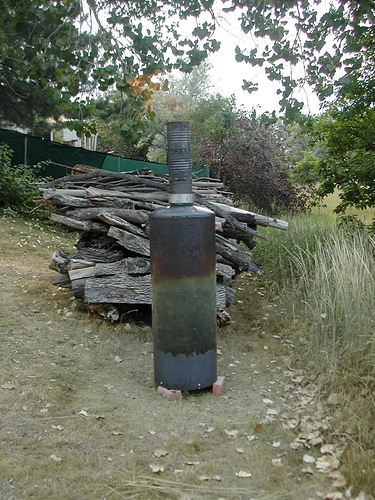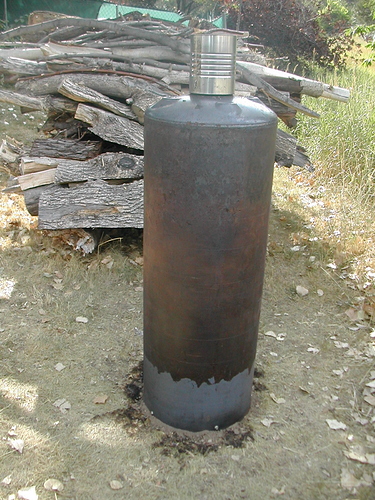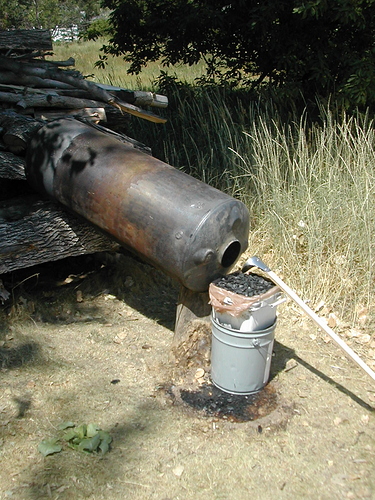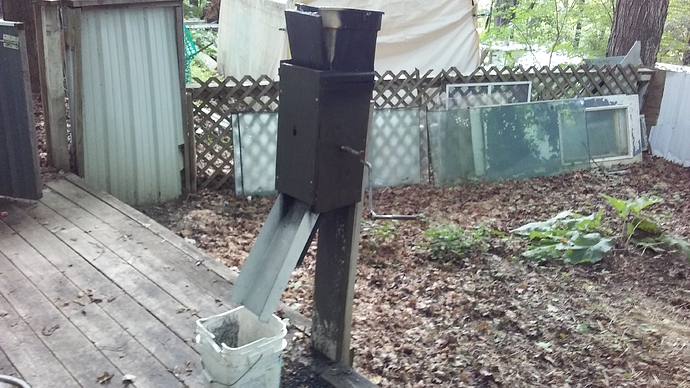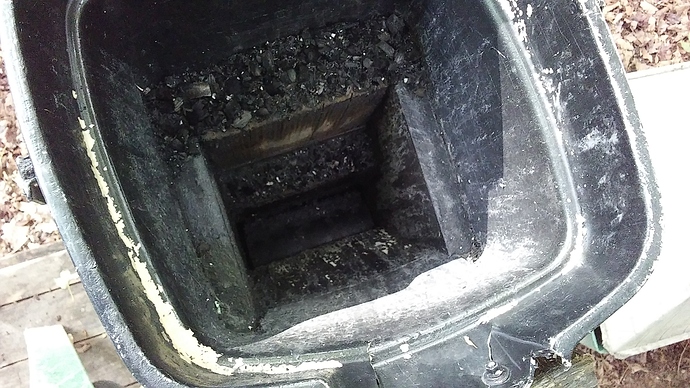Understatement of the year. 
I already make quite a bit of charcoal. Just the typical 55 gallon drum retort. Load it, fire it and then seal it. I grind it and charge it and use a lot of it in my garden beds which are fairly extensive. Wood? I have lost hundreds of Ash trees to the borer. I heat my house totally with wood. Average 10 full cord a year so a stack four foot wide, four foot high and eighty foot long. That not counting what I feed the Rocket Mass heater or the wood stove in the shop. When I built my WK gasifier I was cutting dead fall branches with a chop saw. Just too much work. Was going to make a chunker but other things got in the way. Now I believe it’s time for me to crap or get off the pot. Aside from the political madness I’m watching many geological signs that say the New Madrid quake is on our doorstep. Not the place to get into any discussions like that but for me time is of the essence as far as being able to acquire the materials I need to move forward. Already, and mainly because so much of it was made in China, it’s getting harder to get basic repair components for equipment. It’s important for me to have my own dependable source of electrical power but as important that I can find a way for the homesteaders that I have been involved with for many years, to be able to put together some sort of useable system with less fabrication skills than a hard core enthusiast has. That’s why I liked the idea of the Troy Martz open source unit. No welding required. Where we go one we go all. The future is going to depend on a persons self reliance and personal skillset but we are our brothers keeper and we will not survive or thrive on our own. Sorry to get preachy. Now I have a question. Has anyone dirverted the exhaust gas from what ever engine they are using into a chamber or some sort filled with processed fuel wood in order to accelerate the drying process?
I’ll have to check out those gasifiers you mention Matt. Are cross fires what they were building on Off/gridpro? If I ever get to Muskegon Il stop in. Thanks for the invite. Probably never happen though. I went to Traverse City yesterday for some supplies. That’s only 12 miles and it’s the first time I’ve left my property in about a month. Don’t get around much anymore.
Using engine exhaust heat has decades long been used for fuel drying. However, what I am proposing will require a lot more heat than the engine has to offer. It wont torify the fuel fast enough to keep up with the machine.
Yes the Crossfire is the product of Off Grid Pro
Can you explain?
people that are heavily invested in PV are going to be shocked by whats coming that will make their systems non-functional
Al.
I track geological data. For various reasons the earths core is heating up and exerting a lot of pressure on plate boundaries. This is more the source of global warming than greenhouse gases. USGS is way under reporting quake activity. They have been constant, though small scale quakes on every plate intersection through the planet in recent years. There has been a series of minor quake swarms stretching from Iceland all the way Mexico. There have been volcanic eruptions and precursors to volcanic activity in Iceland and all around the ring of fire. Eventually these volcanoes will build enough pressure that there will be major eruptions. This will put enough ash and sulfur dioxide into the atmosphere to block the suns rays. During the eruption of two volcanoes in our historical recond, Mt Krakatoa and Mr Tubo. There was enough atmospheric pollution to create famine conditions worldwide. No sun, No PV. Not to mention that sulfur dioxide is what we refer to as acid rain. Acid rain deteriorates aluminum quickly. Most PV panels are framed in aluminum. I could be feeding you a bunch of conspiracy theory here but the conditions I’m describing are why I’m working toward food self sufficiency in a controlled environment. Whether it’s do-able is a big question.
Matt. I’m a long way from solving any fuel supply problems. You guys have been working these gas systems for a long time now and I’m sure you have explored all the options I’m just starting to consider. That’s why I join these sites. One thing I have learned so far is that running full tilt, my Rocket Mass Heater will hit over 500 degrees F. on the surface of the barrel with only a wad of sticks you can wrap two hands around. I pump that heat though a two foot wide by seventeen foot long bed of Cob. However I can see how that kind of heat could easily be circulated though a fuel storage container of some kind. I will be building something to try that out after the garden is put to bed for the year.
This is just my opinion, but I think you might be getting yourself a bit too worked up about the dangers of volcanism. Yes, big eruptions would be (and have been) disruptive, but I think you are imagining a scenario that is unlikely to ever happen. If there was so much ash and aerosols that solar panels ceased to function, and that the aluminum frames start to corrode, then there is about a snowballs chance in hell that all the trees are not going to die too (along with everything else, I might add).
If you want the challenge of building a really elaborate system of food production, I think that is as worthy a hobby as any. Lots of people fantasize about escaping to Mars when we have thoroughly wrecked this planet, but it seems to me it would be a lot easier to just build a sealed up tin can to live in here on earth. Is it possible? Sure, anything is possible. With enough dollars you can even land a man on the moon, and set up shop there (no volcanoes on the moon, afterall). Anyway, snide remarks aside, I am curious to see what you dream up.
That is fine. I was just trying to get a feel for where you were exactly. You are a lot further then most. I would try a charcoal gasifier to get your feet wet again. You already have what you need. You just need the larger chunks. The rest go in the compost. (technically, fuel grade should be run to a bit higher temp then biochar as it gets more of the tar out, but you may be doing that anyway and once the bed is heated up it will crack the tar anyway.)
Unless you have a mansion, that is significantly more then the typical house. You might look at insulation or filling up drafts and cracks. I know folks with a wood boiler that had a heated shop and 4 or 5 bedroom house that only used 5 full cords a year… The wood might not be dry enough, and is using too much heat boil off the water, which maybe what you were indicating in your comment.
You might want to check out this section (probably backwards) He is using a hoop house for wood drying. It is similar to a solar wood kiln. You might want to make some adjustments so you can get your tractor in or make it sectional so you can move it over your wood pile.
Hi Tom,
I am not an expert like many on this site are, but I thought I would try and answer a couple of your questions. You can indeed start a charcoal gasifier without a full hopper for a short run and it does work just fine. The extra carbon fuel cools the syngas as it creates additional CO - so that is probably why it is a good idea to fill it up. With less fuel you are just looking at less time before the unit is running low on fuel, the syngas starts heating up, and you need to shut it down to protect the engine. The Off-Grid Pro Crossfire is a good design, it will start generating syngas in 30 seconds or less and generates at least 5KW power - I ran out of items to load down the generator with for my testing. Right now I have all three Crossfire units that were built and I am looking to sell two of them. These units use the TIG cup nozzle they do a great job of dealing with the heat, and they are something like $5 a piece. Sounds like some fun projects, take care.
I didn’t take your post as snide Carl. Each of us has to look at what’s happening in the world and interpret the signs we see. I have no experience with wood gas. Building a gasifier was easy for me. I wake up in the middle of the night thinking about projects I can build. Been like that forever. The way I read the world says the supply lines are breaking and getting the materials I need may soon become impossible. The food supply is in disarray. When we were even allowed to buy seeds and gardening supplies this year they were gone in a week. I just cannot stand the thought that I cannot provide for myself. Never could. Whether I’m right about the volcanoes or not, the food supply is compromised and going hungry is a poor plan for any of us so I attack the problem with as much energy as I can muster in my old age.
Covid will kill us or it won’t. There is no political solution to the problem.
Thanks for the post Todd. I watched a lot of you-tube before I decided to get back into this. I thought that those cross fire gasifiers were well thought out, compact designs. I didn’t realize that there were so many variations of wood and charcoal gasifiers that all seem to be producing clean use able gas. I’m learning a lot here.
I am heating quite a bit of area Sean and our heating season is from October until May. Not many ways I can beef it up. I have an r-50 attic and R-19 glass batts in the walls with 2" styrofoam outside that and an inch of stucco over the foam. I’m sure there are places I could improve but I don’t want a sealed house anyway. I’d rather have a little extra air to breath. I guess I could mention that when I build this place I build several hundred sq feet of glass in the south face thinking I was going to get solar gain. After living here a while I learned that the sun doesn’t shine in the winter here. All that glass just bleeds heat. My wife won’t let me cover the windows. She likes the view.
Hi Tom,
Since you heat with wood anyway, extracting charcoal from that heating process becomes easy.
Use that charcoal as fuel for a gasifier might be an option for your idea thinking ?
Have wood = will have energy…
i personally sealed up mine quite a bit and found a few places that were just letting in cold air, it helped quite a bit. there are still some leaks, but the heating bill is a lot better. My big issue and my parents as well, was the window installers didn’t put insulation -around- the window frames. The cold air wasn’t coming through the windows, it was blowing around the windows. I put spray foam in around the windows. My mom decided to just get new windows.
You can get some solar heating via the windows in the winter. Probably not enough to heat the house. My uncles house had a full wall of windows, with a stone style heat sink and he claimed they only kicked the furnace on a few times a year. They were down by k-zoo. I remember we were there for easter, and there was snow on the ground, it was literally like 90 in there they opened up the doors. You are a bit further north though.
Hope I’m not hijacking Tom’s thread too much, But I started telling about my 50 gallon tlud so maybe I should finish the story. I fired it yesterday. I think it was a success. i got 29.49 pounds of good charcoal and 3.41 pounds of uncooked wood. The afterburner thingy I made out of coffee cans seemed to work very well, except during a few very strong wind gusts. The burn took about 3-1/2 hours. It made very little smoke, but one neighbor did come around because he smelled it. I agree with Koen. “Since you heat with wood anyway, extracting charcoal from that heating process becomes easy.” It was hard watching all the tar and volatiles burn off.
Here the leaves are not on fire, but you can see part of the flame because they create a dark background. You can see how far down the burn has progressed by the discoloration on the tank.
Here I have stopped the burn by taking the bricks out from under the tank, and putting a can in place of the afterburner. Wind gusts made flames come out of the bottom and scorch the grass.
I didn’t have a hoe, so I made something out of a can. Cans are very usefull.

That’s pretty much how I do it except I usually fill a 55 gal barrel with chunks I cut out of my limb piles. I also cut some slots at the bottom and just leave the top off the barrel. To get the wood burning well I use a leaf blower to blow air into the slots. When It’s been burning good I just shovel some dirt over the slots and throw the lid on it. I never weighed the wood fill or the char. Usually burns down to about a quarter of a barrel. I’ll have to look at the thread here and see how I can do it more efficiently.
When I built my original gasifier the biggest problem was making any kind of flanges for the round containers. I tried heating quarter thick by inch and a half strap in my forge but the forge is only sized for making blades and I never could get enough of the iron hot to bend it around a form. Finally cobbled something together out of light weight angle with a lot of kerfs cut into it. Ugly and time consuming. How does anyone else make them?
Wow, am i ever behind on this topic.
ToddH. somewhere above you mentioned annually making up annually 10 cord of wood a year for home heating.
I used too also. Young man in my 20’s, 30’s even up into my 50’s I did this for up to five different households, plus more to sell for extra money.
Just today i visited with my 70 y.o. wood-cutter-buddy brother-in-law who has damn near put himself in the hospital doing his 10 for himself and my sister this summer.
Now for the last 15 years I only use 4-5 cord of our low energy Douglas Fir annually.
Step by step to evolve down to do this.
First. Never burn with visible smoke outside of ~20 minutes after liting off, stove settling in.
Takes a good all SS patent metal tall insulated chimney to start off with.
Then a modern true secondary air clean burning woodstove.
And one that is easy sacrificial thermal brick lined.
Once you learn to in-place HOT, HOT gasify burn you will be eroding out those bricks.
My final squeezing the wood splits for all of their energy was to batch cycle burn in my different air-tight glass front stoves slow&HOT, burning up every spec of the in-stove wood charcoal for the best old bones warming radiant heating.
Ha! Move her sitting chair within this radiant heating zone.
Get her to accept in house differential heated zones.
Learning to go back to fleece house slippers, covered arms and sweaters.
My wood use savings can now give me the “extra” raw wood to be able as needed outbuildings electrical power. Our food freezers as being the priority.
Good solid true zero F. keep the food well out to 7 years.
Now if a fellow was to . . . . an in greenhouse wood gasifier heater would benefit exhaust/waste heat with every BTU heat from the bottom up the grow beds. As much as lighting the growing stocks need soil and growing media grow encouraging temperatures.
KristijanL here did a growing green house hill side with his wood heater dug in below.
For back-to-the-land homesteaders you must favor mass materteral simple robust see-do systems.
Every electric motor needs. Every electric motor controller and power supply will be a stop failure system sooner versus later.
Why a heat pressure cooker/canner beats all, versus the newest tech hot air fryer.
A food drier can too be made motor-less.
Ha! For years I have try to coach along my oldest B-I-L; just as I did the Wife’s father on wood-stretching. But they liked their old too open insides lazy draft brick masonry chimneys; and their choked back, only lite-up once a week, glass blackening, soots making smoky fires.
So there is a such a thing of being too simple, and too traditional too.
Regards
Steve unruh
Hi Tom,
If there are tree trimmers in your area, a load of hardwood chips can be pre-processed by screening between 1 inch and 3/8 inch screens. Easy to dry and pyrolyze these classified chips into engine grade charcoal in a giant TLUD.
If i had a heavy duty built wk unit, and was running any smaller motor than v8 or maybe v6 No smaller, or i would keep every thing the same except add a ceramic blanket too keep the temps up higher for smaller motors. Just my own opionion as too holding temps up high enough on smaller vacuem motors.I think Wayne K runs his big 4 cylinder tractor motor at high rpms for chunking wood.
Hi Rindert,
I’ll offer a suggestion to make your water tank kiln burn cleaner and make it easier to fill and empty. Cut a hole in the top 10 or so inches in diameter. Right now you are constricting the exhaust vapors to a hole which makes it harder to flare the gases not to mention harder to fill with wood and remove the char. Instead of a coffee can, use a five gallon metal bucket ( with the top and bottom removed) for your after burner. You could also use a 10" diameter section of stove pipe. Insulation around the outside will help with efficiency. You can also wrap the outside of the tank with corrugated sheet metal to help keep the air from cooling the outside of the kiln. Your system will make some high temperature charcoal that in turn makes good engine grade char. Isn’t making charcoal fun?!???
Gary in PA
Hard to teach an old dog new tricks Steve. I’m sure there are a thousand ways I could have a more efficient heating system, but the one I have is encased in concrete and stone and we have come to terms with each other in the 25 years since I built her. I have radiant floor on both stories of my house and aside from providing radiant heat from a fan blowing hot air through channels around the fire box I heat two separate water tanks to pump hot water through the floors. My main problem which will never be resolved is that I didn’t insulate under the lower level slabs because at that time there was a debate about whether is was better to go uninsulated and bleed extra stored heat into the soil below the slab. It’s not. However I do have a convoluted smoke path coming out of the fire box and the ducting is encased in concrete for thermal mass and past that my flue which is made out of six inch sch 80 steel pipe has a rise of 28 feet. Even a couple of feet out of the top of the stove the flue hardly even goes more than 220 degrees which would not pass code today but I only run very hot fires and only have to clean out the flue even at those low temps once during the heating season.
Last year was the first time I ever bought a wood splitter. For all the years before that I split all my firewood with a maul. I figured as long as I could do that I wasn’t old. The only hard thing about fire wood for me is that my woods in all hills and I have to cut it and then usually roll it down a few levels before I can get it in the truck. Despite the fact that he was a communist, I have always admired Scott Nearing. If you read old MEN’s you would know who that is. He worked until he was I think in his nineties and then decided it was enough and quit eating, or so the myth goes. When I can’t work any longer there is no reason for me to hang around. I don’t even own a rocking chair. Anyway I did not realize there were such diverse topics on this site. I’d like to swap stories with KristijanL about his greenhouse and I know something about hydronics and thermodynamics and if anyone want to know how to burn up a lifetimes worth of tools in an hour I can help out with that as well. Now I have to figure out how to post these damned pictures. Me and computers are not simpatico. I know how to turn one on and get on the WWW and that just about it.
All, sounds good TomH.
Mass durability.
Nothing better than the voice of experience.
Uphill wood harvesting is manual O.K.
Downhill wood though is a mankiller.
Fellow just needs moving power and equipment’s.
Gary Gilmore here shows powering his wood splitter with one of his charcoal gasfier systems.
He’s also charcoal powered up a H.F. inverter-generator unit.
And i sold my V twin fuel injected 12kw Miller/Kohler Trailblaser welder-generator to Ben Peterson.
And as Kevin pointed out, now many of the vehicle woogasifer guys have well proven their large vehicle systems can very well for six hours woodgas fuel electrical generators’ too.
Always more than one way to skin the wood-for-power cat.
Select out. Use learn, at least three ways.
Then you are set up; come Hell, High water, or the Second Coming of Christ.
Here in the Ring of Fire most expected Real would be earthquakes. Then wind storms.
The third most likly would be a toss up of many minor could/has happened. Like ice storms.
Others should have near annual tornadoes, or hurricanes at the top of their at least every 7 years; will-happen, lists.
Actual flooding’s, landslides, avalanches are really localized situations best to, recognize and move over a bit, just step aside from.
So speaks this third generation high mountain riverside cabin owner who ain’t rebuilding from the fourth flooded out event in 50 years! Re-site this just 200 feet away and cabin flooding would have never happened.
Regards
Steve Unruh
Don wanted to see this from a different thread. It a charcoal grinder I put together one afternoon. This view is just a plywood box with a square plastic pail on top for a hopper,
Looking down the hopper to the grinding mech.
Front cover off showing plywood diverter that funnels the charcoal into the grinder.
Not a real good view without disassembling the rest. The actually grinding mechanizm is a piece of three inch ID pipe cut in half. A flat plate is welded to that to form a J shape. You can just see the edge of that three inch pipe below the cylinder. The cylinder is a piece of two and a half inch OD pipe with lengths of half inch all threaded welded on it in four places. A piece of half inch all thread is centered in the pipe and extends through the sides of the box. There is no bushings. The rod just rides in the holes drilled in the plywood. It just hand cranks. Occasionally a larger piece will jamb the roller. You just have to rotate the thing backwards to free it up. That’s why I probably wouldn’t work with a motor or drill attached to it. Using pipe makes this easy but not everyone had pipe that size. Actually any size pipe would work as long as the cylinder as long as the cross bars did not allow larger pieces of char to pass through. This was a simple thing to make but I’m leaning more to something like Gary Gilmore made a video of.
